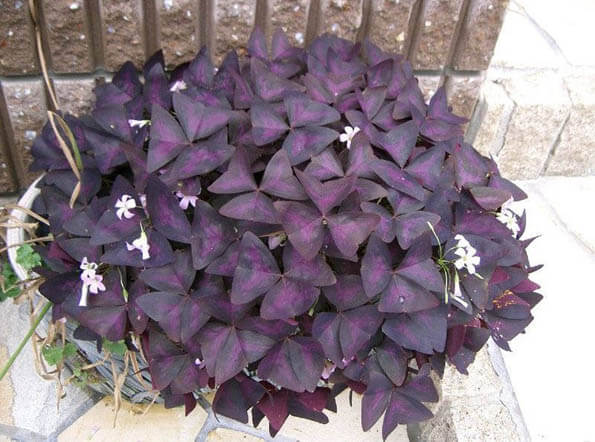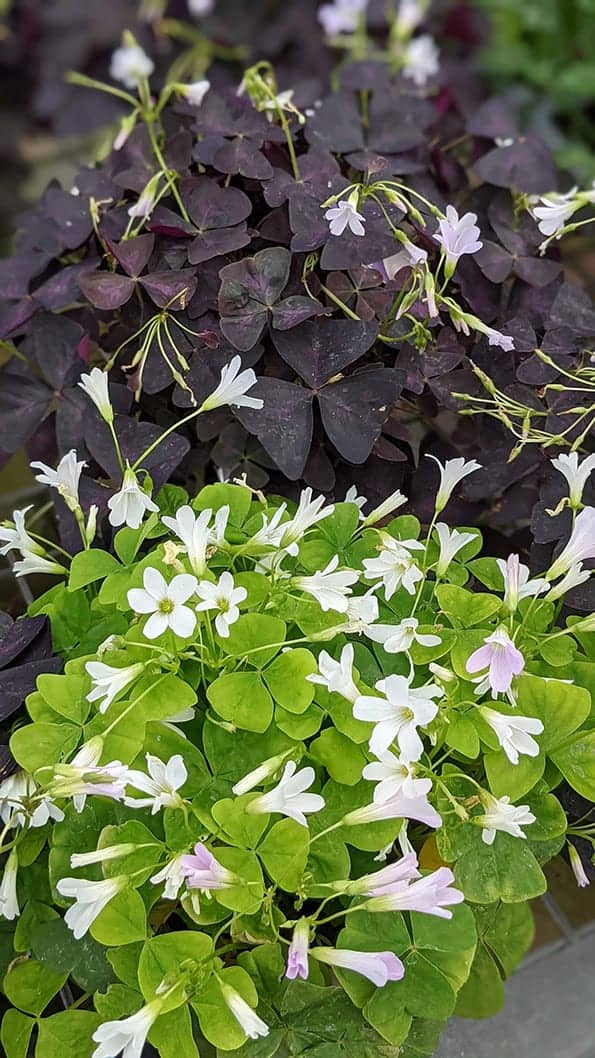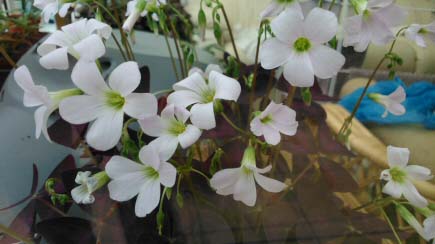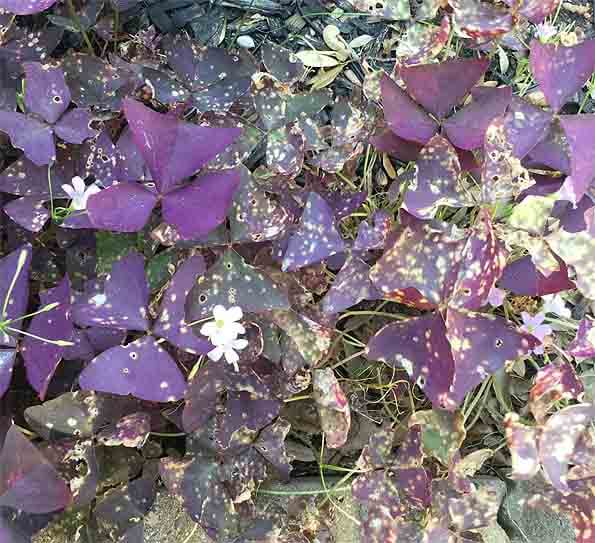Three is often the magic number when it comes to Oxalis. The most common species grown as a houseplant is Oxalis triangularis which has three common names, False Shamrock, Purple Shamrock and Love Plant.
It has three (normally) purple heart shaped leaves, which each have three sides, that sit symmetrically to one another at the end of every petiole (or "stem"). The overall effect is that they end up looking like a trio of butterflies joined together by their noses.
Other species are similar in shape, except they tend to have green leaves instead.

The plant is also a little bit magic, because it can revive itself from the dead! Rather than being intrinsically linked with the soil like many other plants, Oxalis is linked to the soil by its tiny bulbs.
Forget to water it, temperature drops too low or its living conditions are generally poor, everything above the surface will wilt and die back to take refuge in the bulbs below.
As soon as good conditions are restored the plant comes back to life incredibly quickly. This is great for those little accidents where we might forget to water our houseplants for several months at a time. Not so good for those who live in temperate regions of the world where this plant can be viewed as a weed.
Let's not dwell on such things though!
The plant is dainty and elegant with pretty looking leaves, everything stays compact if kept in a pot which makes it an ideal house or office plant in many respects.

Oh My Plant perfectly captures the alluring appeal of these houseplants in this photo
It throws out one last bit of magic with its white flowers that emerge on mass above the darker colored purple foliage below, creating a strong contrast that really makes them stand out.
Are you sensing a but coming? If so, well predicted. Despite all its positive points the Purple Shamrock is actually quite rare to find living in peoples homes.
Oh yes, it's much more common to grow Oxalis outside amongst your Summer Bedding, the annuals, perennials or shrubs. It's a gardeners plant in many respects. But the reason it's not grown inside more is a bit of a mystery to us.
The leaves are poisonous to pets, although a little nibble of this plant and most wont be back for seconds.
It's true it's poisonous to pets, although again it has a helpful magic trick by making the leaves taste awful. A little nibble of this plant and most pets won't be back for a second helping. You can therefore certainly grow them in homes with pets so don't let that put you off.
If however you have a pet (or child) that nibbles houseplants it might be best to pick something else or make sure your Shamrock is out of reach.
Another possible suggestion for this "unpopular" mystery could be its general rarity and difficulty to purchase in many normal shops.
This is one instance where online sellers like those on Amazon, have the advantage. Oxalis can easily be sold in bulb form. You get them this way and pot them up in soil. A bit or water, some warmth and a few months later you'll have your own full pot growing away happily.
With all things considered this is a beautiful and alluring easy going houseplant so we can't really explain it's lack of popularity with certainty. If you've any ideas or thoughts about this let us know in the comments below. Meanwhile onwards to the Purple Shamrock care tips.

Hi, I'm Tom!
If you're like me and enjoy the challenge of growing houseplants and getting them to thrive, then Ourhouseplants can help. This website shares my knowledge and years of growing plants and provides (hopefully) helpful advice on properly caring for your indoor plant friends.
Oxalis is not overly fussy with its light requirements. The species with purple leaves will take less bright areas than its all green leaf cousins.
However for a good looking plant you're going to want an area which receives bright light, or even some sun for a few hours a day. Don't overdo the sunshine though, too much sun will damage the leaves.
The leaves move throughout the day, often turning to face light sources. During the day with good light hitting the leaves, they should open wide and then as the day draws to a close the leaves close slightly. If you're not seeing any movement with the leaves at all, then it could be an indication that the plant is in a dark position and needs a bit more light.
Ideally soak the soil and then allow the top inch or so to dry out before watering again. Although irregular and random watering is not a problem here, in fact the plant can often go months without adverse effects especially when it's cooler.
If it's very warm or it sits in a very bright spot you will need to make an effort to water regularly, because if things get too dry the plant will die back.
Further reading -
Is it better to bottom water or top water?
A misting once in a while to help keep the leaves free of dust would be appreciated. But the Purple Shamrock is easy going when it comes to humidity levels and so there is no need to worry about it or mist on a regular basis.
Feeding only needs to be done infrequently, so using an all purpose fertiliser at normal strength once every couple of months is plenty.

The two common types of Shamrock Plant. The classic purple and the all green variety. If well looked after, both will produce similar looking flowers.
As a houseplant, you don't need to worry about the temperature level very often. If given the choice they they do prefer cooler spots in your home, but will still do okay in warmer living spaces.
However in very warm rooms, or spaces that heat up, like those near a window you need to be careful. If the temperature gets above 25°C (77°F) on a regular basis it will very quickly "age" the plant and make it look ragged and unattractive.
Sitting in a very warm room, will quickly "age" the plant
You might not think your house gets this warm, but window ledges with full sunlight beaming through can become serious heat spots pretty quickly so be careful.
Try to keep it in a location that has average levels of warmth. The plant will even do quite well in cooler places to like an unheated porch or hallway. Just don't expose the plant to sub zero temperatures and it will be fine.
Because the Purple Shamrock is reasonably compact, repotting only needs to be done every few years. Perhaps when the plant has spread to all sides of the pot or you want it to become more bushy. In any case, a general all purpose compost will be absolutely fine as long as it has good drainage.
Creating new plants is really easy to do. In most pots there are many many bulbs of which a small section of the overall plant belongs. All you need to do is divide the "clump" and plant the bulbs up in different containers, the new "clump" will produce more bulbs and gradually fill its new home.

Try not to keep the bulbs too close together when you are repositioning them in their new pot(s), if you spread them over the container's surface it will create more space and give the appearance of a fuller plant faster.
No matter what anyone tells you, you really don't need any fancy compost or soil, just use a potting mix that is similar to what the bulbs were growing in previously. Keep the pot reasonably warm and reduce watering until the bulbs have established fully and are producing new shoots.
New growth is rapid. Once Purple Shamrock has become established or there is no space for it to grow into, it will slow down. At this stage you can either repot or divide your Oxalis, or leave it alone to keep the compact nature.
Expect a max height of 25cm / 10in and it will spread to fill the size of the container you have put it in. A large wide container will mean a wide overall plant (see the first photo at the very start of the article to see how wide yours could get!).
The flowers are generally white with purple and pink hues mixed in. Like the plant itself, the flowers are also dainty and they form in small clusters which last for several weeks sitting a few inches above the leaves.

They could bloom at anytime of the year, however it's normal to expect them to appear only in the Summer. Once the blooms start to die down, it's best to carefully snip them off as close to the base as possible. If you don't, they will dry out and become stringy before falling onto the leaves below and making them look messy.
Although Oxalis is toxic it has a very bitter taste to repel anything or anyone who tries to eat it, and this is often enough to deter dogs and cats from eating more than the occasional mouthful. However, when ingested in large quantities it can result in poisoning in cats, dogs and humans.
The bulbs are where the highest concentration of the toxic compounds can be found. So in theory they're hidden from view beneath the soil.
You'll need to decide if you have a pet or child that doesn't give plants a second glance or one that's always nibbling and playing with them. If the latter you'll need to grow your Shamrock out of sight or consider growing something more pet friendly in its place.

Mars the cat is only curious but Oh My Plant keeps an eye on him just in case
Although tolerant, if your treatment of the Purple Shamrock is anyway close to brutal you will quickly force it into die back mode, known more correctly as dormancy. This results in everything above the soil dying and taking shelter in the bulbs which sit just below the soil.
All is not lost however, because the plant will resurrect itself if the conditions improve. In many cases die back has happened because you have not watered it in months, so if you soak the soil, the plant should kick start back into life pretty quickly.
The comments from many readers at the bottom of this article show this method works and that this is one tough cookie of a houseplant.
Good Light Levels Some sun will be helpful if possible, but it's not essential. Deep shade and no light locations need to be avoided.
Average Watering Water well and then wait until the soil is almost dry before watering again.
Temperature Average to cool room temperatures are preferred. Very warm temperatures will result in distorted growth.
Feeding Feed once every couple of months.
Leaves keep moving and changing position
Not a problem but rather a natural quirk of the plant. The leaves move in response to light. They "open" wide in high light (i.e. during the day) and "close" at low light levels (i.e. at night). They also move if you touch the leaves, although a lot lot slower than a Venus Fly Trap or Tickle Plant.
Die back / Dormancy
Again this is normal although not inevitable, so if you want to avoid it, treat your Purple Shamrock right and follow the care instructions we've provided above.
White spots on Purple Shamrock leaves
White Spots on your Oxalis plant can be caused by several different things and it will depend on how many spots, how extensive they are etc. Below are some suggestions with tell tale signs to look for.

The first three problems above can be sorted out without too much fuss, but the final possibility means there is no cure as the bulbs become carriers of the virus.
The markings on the leaves can be really disfiguring and ruin the look of these elegant plants, so in this instance it's worth considering replacing the entirety of the existing bulbs with new ones. Be sure to use a different pot (or scrub the old one clean) and use fresh compost to stop the virus spreading to the new bulbs.
Weak and lanky looking plant
If temperatures are quite warm for prolonged periods, it hasn't been repotted for ages, or has generally only received below average care for many months the plant might start to look a bit rubbish. If this ever happens you could be better off here withholding water completely so the plant goes into dormancy.
When this has happened wait a few more weeks before you resume watering again. When you do, the bulbs will quickly grow new shoots and the plant will be restored just like magic! (Although not instantaneously and not really by magic because it's nature really ;- ).
Credit for several Oxalis triangularis photos - Article / Gallery - KENPEI
Credit for Single Oxalis leaf / Credit for Mars the Cat - Article / Gallery - Oh My Plant